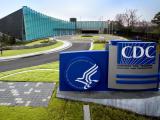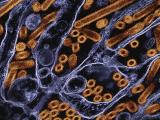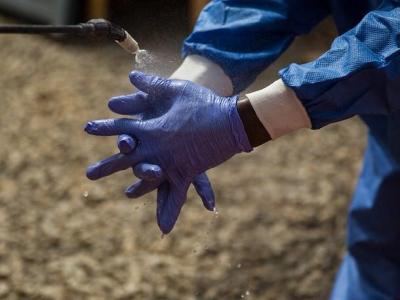Editor's note: This is the sixth in a seven-part series investigating the prospects for development of vaccines to head off the threat of an influenza pandemic posed by the H5N1 avian influenza virus. The series puts promising advances in vaccine technology in perspective by illuminating the formidable barriers to producing large amounts of an effective and widely usable vaccine in a short time. Part 5 looked at the idea of vaccinating people before a pandemic with a best-guess vaccine and following up later with a vaccine matched to the emergent pandemic strain.
Nov 1, 2007 (CIDRAP News) – Frustration with the slow pace of pandemic-vaccine achievement has spurred second looks at both old and new technologies, such as using whole influenza viruses instead of fragments or growing flu viruses in cultures of mammalian cells instead of in eggs.
Such approaches may yield cross-protection against various H5N1 strains, shorten the production timeline, or increase the amount of vaccine that can be produced. As with the inactivated subvirion or split-virus vaccines, however, much of the research into new types of vaccines and forms of delivery is in its early stages, and the vaccines could be years away from marketability. Few of them pass the real-world tests specified recently by David Fedson, MD, in the Permanente Journal. Fedson, a retired vaccine-industry executive who has analyzed pandemic vaccine planning, wrote that the vaccines must be "scientifically promising," they must be "licensed or near licensure," and "the global industrial capacity to produce them must be large and already in place" (see Bibliography: Fedson 2007: New approaches).
Among older and known technologies, the lure of cross-reactive protection has spurred a second look at inactivated whole-virus and live-attenuated flu vaccines. Some whole-virus trials have returned encouraging results. But in the past, whole-virus vaccines' much higher rate of adverse reactions has kept them out of commercial use in the United States. As a result, "if whole-virus vaccines are confirmed to be more immunogenic than subvirion vaccines, this will pose challenges to manufacturers and regulators, since it will require substantial changes to existing licensed production processes," Iain Stephenson of University Hospital-Leicester and colleagues observed in Lancet Infectious Diseases (see Bibliography: Stephenson 2006: Development of vaccines against influenza H5).
Pros and cons of live vaccines
Live-attenuated vaccine has been the Cinderella of the seasonal flu vaccine world, struggling for market share since it was introduced in 2003 by MedImmune (now part of AstraZeneca). Even during flu-shot shortages, its acceptability was hampered by restrictive FDA indications limiting its use to 5- to 49-year-olds, as well as a formula that required physicians to keep it frozen (see Bibliography: Rosenwald 2007). The vaccine was relaunched this year with a new formula that requires only refrigeration, along with a broadened indication permitting use in children as young as 2 years old, backed by research showing that it protected young children better than a shot (see Bibliography: Belshe 2007).
Because they contain live virus, live-attenuated vaccines provoke multiple types of immunity. In studies they have been shown to protect against both the strains from which vaccine candidates were derived and against drifted (slightly mutated) strains as well—characteristics that make them highly appealing to pandemic planners (see Bibliography: Belshe 2004). They also grow in eggs at a much higher volume than inactivated vaccines (see Bibliography: Monto 2007). But their live-virus content is responsible for the vaccines' greatest potential danger: the possibility that they might lead to reassortment between the vaccine virus and circulating flu strains.
"Although such an event may not be of concern in the face of widespread disease from a pandemic strain of influenza, it would clearly be an unfavorable outcome if the threatened pandemic did not materialize," Catherine Luke and Kanta Subbarao of the National Institutes of Health (NIH) wrote last year. They called for clinical trials of live-attenuated pandemic vaccine candidates in which, to eliminate the risk of reassortment, participants would be kept in inpatient isolation. "The risk for reassortment must be carefully considered by public health authorities before a decision is made to introduce a live, attenuated vaccine in a threatened pandemic," they stated (see Bibliography: Luke 2006).
Alternate routes
Some researchers have urged attention not to new vaccines, but to new methods of administering vaccines. Intradermal vaccination appears to provoke acceptable levels of immunity while using only 20% to 30% of the standard intramuscular dose—but the injection technique is more challenging and may not be feasible for mass vaccination programs that might use less-trained volunteers (see Bibliography: Haaheim 2007).
In another novel suggestion, academics from the University of Hong Kong recommended recently that health authorities consider giving lower-than-planned doses of vaccine during a pandemic, arguing that vaccinating more people with a reduced dose could create a mass effect large enough to slow down spread of the disease (see Bibliography: Riley 2007). That approach too has drawbacks, Christophe Fraser of Imperial College London said in a commentary: "We must . . . consider whether anyone is ready for the potential consequences of deploying a suboptimal vaccine in an uncertain attempt to maximize our herd protection, with a possible reduction in the extent of protection of individuals" (see Bibliography: Fraser 2007).
The promise of cell-culture production
The simplest but in some ways most challenging proposals for addressing the slow development of pandemic vaccines are ones that directly address the shortfall in flu antigen by radically changing production techniques.
Cell culture is a known technology that is used for vaccines such as inactivated polio vaccine, but in the United States it has never been applied to flu. Moving flu vaccine production from eggs to cell culture would simplify manufacturing in several key areas. It would free manufacturers from the necessity of procuring enough eggs up to a year in advance. By dispensing with eggs, it would eliminate the need for putting a pandemic virus through reverse genetics, shaving 4 to 6 weeks off vaccine production. And because the vaccine virus is grown in giant industrial fermenters, it could offer a vast increase in production capacity—but only if manufacturers or governments make significant capital investments (see Bibliography: GlaxoSmithKline 2005, Novartis 2006) or manufacturers quickly convert the 2.5 million liters of cell-culture capacity (see Bibliography: FDA 2007: Committee meeting transcript) in use around the world for other pharmaceutical products. Either method of creating additional capacity would require the approval of regulatory bodies such as the Food and Drug Administration (FDA) before production could begin, unless governments enacted some form of emergency release.
But additional investment at least is beginning: The Department of Health and Human Services (HHS) awarded $97 million to one manufacturer in 2005 and just over $1 billion to five manufacturers in 2006 (see Bibliography: HHS 2006), and manufacturers Novartis and GlaxoSmithKline have both begun building cell-culture plants in the United States. The first cell-culture vaccine for seasonal flu, made by Novartis, was approved by European Union authorities in June (see Bibliography: Novartis 2007: Novartis gains European approval).
A refinement of the cell-culture strategy involves isolating the flu virus's hemagglutinin gene and using recombinant technology to express the hemagglutinin in insect cells grown in bioreactors. The main commercial proponent of this process, Protein Sciences Corp., claims it can halve the standard production timeline while delivering higher yields (see Bibliography: Lauerman 2007). The baculovirus-expressed recombinant product has been successfully tested for safety and immunogenicity (see Bibliography: Treanor, Schiff 2006; Treanor, Schiff 2007), and the company has said it plans to submit a trivalent, seasonal-flu version of the vaccine to the FDA for licensure before the end of 2007 (see Bibliography: Protein Sciences Corp. 2007). Submission of a recombinant pandemic vaccine would follow approval of the seasonal vaccine, chief operating officer Manon Cox said at an FDA hearing earlier this year (see Bibliography: FDA 2007: Committee meeting transcript).
The Holy Grail
The Holy Grail of flu vaccine—and the object so far of the greatest wistfulness—is a universal vaccine. "The optimal long-term solution to pandemic vaccination is the development of a new influenza vaccine against an antigen that is present in all influenza subtypes and does not change," Ben Schwartz and Bruce Gellin of HHS's National Vaccine Program Office wrote in 2005 (see Bibliography: Schwartz 2005). So far, however, vaccines based on conserved regions of the virus such as the M2 protein have shown only the ability to reduce disease, not to prevent infection, and have been tested largely in animals, though one clinical trial in humans began last summer (see Bibliography: Acambis PLC 2007).
The pandemic vaccine puzzle
Part 1: Flu research: a legacy of neglect
Part 2: Vaccine production capacity falls far short
Part 3: H5N1 poses major immunologic challenges
Part 4: The promise and problems of adjuvants
Part 5: What role for prepandemic vaccination?
Part 6: Looking to novel vaccine technologies
Part 7: Time for a vaccine 'Manhattan Project'?
Bibliography
















